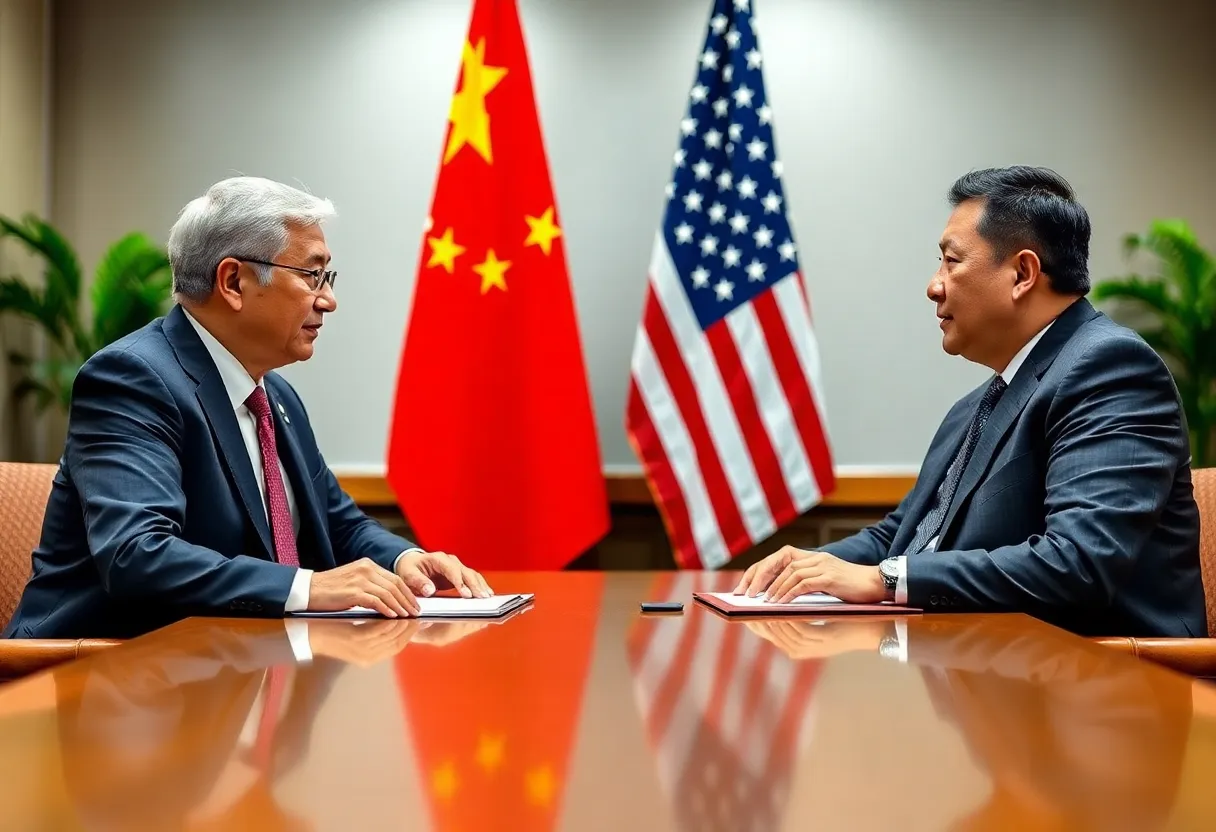Busan, South Korea, October 31, 2025
In a significant development aimed at easing trade tensions, U.S. President Donald Trump and Chinese President Xi Jinping have established a one-year truce in their trade dispute. Meeting in Busan, South Korea, the agreement includes measures such as suspending China’s rare earth export restrictions and reducing U.S. tariffs on certain Chinese goods. While the accord aims to bolster global market stability, mixed reactions from markets indicate ongoing concerns about the U.S.-China economic relationship.
Trump and Xi Reach Significant Trade Truce
Busan, South Korea – In a noteworthy move toward alleviating years of contentious trade relations, U.S. President Donald Trump and Chinese President Xi Jinping have forged a one-year truce in their ongoing trade dispute. This agreement achieved during a crucial meeting in Busan, South Korea, encompasses several pivotal measures including the suspension of China’s rare earth export restrictions and a strategic reduction of U.S. tariffs on selected Chinese goods.
This trade truce highlights an effort to revive cooperation and stability in global markets, particularly in light of the challenges that businesses have faced amid rising tensions. Advocates for a more collaborative economic approach argue that diplomatic resolutions like this could pave the way for enhanced entrepreneurial innovation and resilience, especially in small businesses that have been impacted by the trade war.
Key Provisions of the Agreement
- Rare Earth Exports: China will suspend its export restrictions on rare earth elements for a full year, offering relief to industries reliant on these essential materials, such as technology and defense.
- Tariff Reductions: The United States will lower tariffs on certain Chinese goods from 20% to 10%, specifically targeting fentanyl-related products. This adjustment is designed to encourage Chinese efforts to mitigate the flow of fentanyl into the U.S., addressing critical public health concerns.
- Agricultural Trade: China has committed to resuming substantial purchases of American soybeans and other agricultural products, pledging to acquire up to 25 million metric tons annually over the next three years. This commitment is expected to ease the burdens on U.S. farmers affected by prior trade disputes.
Market Reactions
Market reactions to the announcement of the trade truce have been mixed. Asian markets, including the Hang Seng and Shanghai Composite, saw declines as worries lingered over U.S.-China tensions and reports of slowing factory activities in China. Conversely, U.S. markets exhibited signs of stabilization, with major indexes like the S&P 500 and Nasdaq reacting positively to the potential easing of trade tensions.
Background Context
Since the onset of the trade conflict in early 2018, characterized by the U.S. aiming to address concerns over unfair trade practices and intellectual property rights, both nations have imposed tariffs and trade barriers that have reshaped international economic dynamics. Efforts to de-escalate the situation have encountered setbacks, yet this agreement could represent a pivotal moment for small businesses and entrepreneurs who thrive on collaborative economic relations.
Continuing Challenges
Despite this carefully negotiated trade truce, significant underlying issues remain in the U.S.-China trade relationship. Topics such as market access, intellectual property rights, and China’s manufacturing dominance continue to be contentious and could hinder long-term trade stability.
Conclusion
The agreement between President Trump and President Xi signifies a noteworthy step toward reducing trade tensions, which has implications not only for the two nations but for global markets and local economies. As New York businesses keep a close eye on these developments, fostering a culture of innovation and entrepreneurship will be crucial in adapting to the evolving trade landscape. Supporting local businesses and encouraging engagement in the economic future can further bolster New York’s standing as a vibrant business hub.
Frequently Asked Questions (FAQ)
What is the duration of the trade truce between the U.S. and China?
The trade truce agreed upon by U.S. President Donald Trump and Chinese President Xi Jinping is set to last for one year, during which certain trade restrictions and tariffs will be suspended or reduced.
What specific measures are included in the U.S.-China trade agreement?
The agreement includes the suspension of China’s rare earth export restrictions for one year, a reduction in U.S. tariffs on Chinese goods from 20% to 10% on products related to fentanyl, and China’s commitment to resume large-scale purchases of American soybeans and other agricultural products, pledging to buy up to 25 million metric tons annually over the next three years.
How have global markets responded to the U.S.-China trade truce?
Global markets have shown mixed reactions. Asian markets, including the Hang Seng and Shanghai Composite, declined due to ongoing concerns over U.S.-China tensions and reports of contracting factory activity in China. In contrast, U.S. markets exhibited signs of stabilization, with major indexes like the S&P 500 and Nasdaq retreating from recent highs amid investor optimism about the de-escalation of trade tensions.
What are the underlying issues that remain unresolved despite the trade truce?
Despite the trade truce, fundamental issues such as market access, intellectual property rights, and China’s manufacturing dominance remain unresolved. These underlying tensions continue to pose challenges to the long-term stability of U.S.-China trade relations.
| Feature | Description |
|---|---|
| Duration | One-year suspension of certain trade restrictions and tariffs |
| Rare Earth Exports | China suspends export restrictions for one year |
| Tariff Reductions | U.S. reduces tariffs on Chinese goods from 20% to 10% on fentanyl-related products |
| Agricultural Trade | China commits to purchasing up to 25 million metric tons of American soybeans annually over the next three years |
| Market Reactions | Mixed responses; Asian markets decline, U.S. markets stabilize |
| Unresolved Issues | Market access, intellectual property rights, and manufacturing dominance remain contentious |
Now Happening on X
- @izurietavarea (October 31, 2025): Savage analysis from The Economist notes New York is “definancializing,” with fewer new finance jobs and a shift toward healthcare and social assistance roles amid years of decline. View on X
- @yankeefina87656 (October 29, 2025): Everything is booming in NYC with zero vacancy rates, record-high rents, luxury condos selling at $7k per square foot, thriving offices, expensive hotels, and packed restaurants unlike in other cities. View on X
- @Cobyvu8820 (October 28, 2025): NYC’s venture ecosystem sees a polarized Q3 2025 with $608M invested in 391 deals, up 5% in capital but the lowest deal count since early 2024, highlighting a capital surge amid a deal drought. View on X
- @bizfacilities (October 28, 2025): New York leverages its strengths to achieve gains in domestic and international markets, focusing on corporate real estate, economic development, and site selection. View on X
- @BfloBizFirst (October 30, 2025): In Western New York, development has been sluggish post-pandemic, but signs of momentum are emerging with over 1,000 new projects underway. View on X
- @BfloBizFirst (October 31, 2025): Western New York’s development pace shows building momentum post-pandemic, with more than 1,000 indicators pointing to renewed activity. View on X
- @elle_kaye11 (October 25, 2025): Warns of accelerating NY exodus as 56 investment banks have left the city, with only 6,000 new jobs added YTD through August—far below the usual 200,000—and the second-largest money outflow after California. View on X
- @MikeMaxAlabama (October 27, 2025): Financial services, NYC’s key taxpayers and employers, are shrinking with an 8,400-job loss from January to August, accelerating the exodus from New York. View on X
Deeper Dive: News & Info About This Topic
HERE Resources
U.S. Soybean Farmers Celebrate Major Trade Boost with China
NFL Teams Prepare for Trade Deadline and Running Back Moves
U.S. Stocks Rebound as Trump Reassures Investors
Wall Street Opens Higher on Strong Bank Earnings
Bank of America Selects Local Businesses for Spotlight Program
Small Businesses Shine at Winter Village in New York City
Pakistan’s Ambassador Promotes Home Textiles in New York
New York Businesses Face Challenges Amid Federal Tariffs
U.S. Stock Market Reaches New Heights Amid Trade Optimism
Small Businesses Brace for Price Increases Due to Tariffs
Author: STAFF HERE NEW YORK WRITER
The NEW YORK STAFF WRITER represents the experienced team at HERENewYork.com, your go-to source for actionable local news and information in New York, the five boroughs, and beyond. Specializing in "news you can use," we cover essential topics like product reviews for personal and business needs, local business directories, politics, real estate trends, neighborhood insights, and state news affecting the area—with deep expertise drawn from years of dedicated reporting and strong community input, including local press releases and business updates. We deliver top reporting on high-value events such as New York Fashion Week, Macy's Thanksgiving Day Parade, and Tribeca Film Festival. Our coverage extends to key organizations like the Greater New York Chamber of Commerce and United Way of New York, plus leading businesses in finance and media that power the local economy such as JPMorgan Chase, Goldman Sachs, and Bloomberg. As part of the broader HERE network, including HEREBuffalo.com, we provide comprehensive, credible insights into New York's dynamic landscape.





